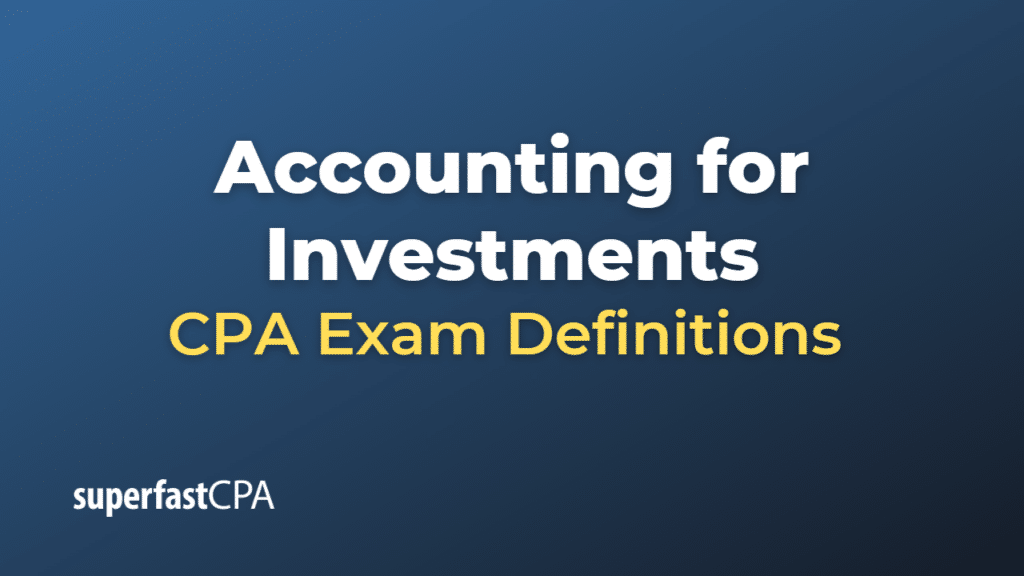Accounting for Investments
Accounting for investments involves the identification, recognition, measurement, classification, and disclosure of investments in a company’s financial statements. Investments can include equity securities (e.g., stocks), debt securities (e.g., bonds), and other financial instruments. Proper investment accounting is essential for businesses to accurately reflect the value of their investments, the related income or gains, and any associated risks.
Under U.S. Generally Accepted Accounting Principles (GAAP) and International Financial Reporting Standards (IFRS), investment accounting is primarily governed by FASB’s ASC Topic 320 and IAS 32, IFRS 9, respectively.
Here are the key aspects of accounting for investments:
- Identification: Determine which financial instruments should be considered as investments. This can include equity securities, debt securities, and other financial instruments.
- Classification: Investments can be classified into various categories depending on the company’s intention and ability to hold or sell the investments:
- Held-to-maturity (only applicable to debt securities under U.S. GAAP): These are debt securities that the company has the intent and ability to hold until maturity.
- Trading securities (both equity and debt securities): These are investments held for the purpose of selling them in the short term to take advantage of market fluctuations.
- Available-for-sale securities (both equity and debt securities under U.S. GAAP): These are investments not classified as held-to-maturity or trading securities.Under IFRS 9, the classification is based on the company’s business model and the contractual cash flow characteristics of the financial assets. This results in categories such as amortized cost, fair value through other comprehensive income (FVOCI), and fair value through profit or loss (FVTPL).
- Measurement: The initial measurement of investments is at their cost, including any directly attributable transaction costs.
- Subsequent measurement: The subsequent measurement of investments depends on their classification:a. Held-to-maturity (U.S. GAAP): Measured at amortized cost using the effective interest method.b. Trading securities: Measured at fair value, with unrealized gains and losses recognized in the income statement.c. Available-for-sale securities (U.S. GAAP): Measured at fair value, with unrealized gains and losses recognized in other comprehensive income (OCI) and accumulated in equity.Under IFRS, the subsequent measurement follows the classification based on the company’s business model and the contractual cash flow characteristics of the financial assets. This results in categories such as amortized cost, FVOCI, and FVTPL, with different treatments for gains, losses, and interest or dividend income.
- Impairment: Assess investments for impairment periodically or when there is an indication of a significant or prolonged decline in the fair value of the investment. If an impairment loss is identified, recognize it in the income statement.
- Derecognition: Remove investments from the balance sheet when they are sold, matured, or otherwise disposed of. Recognize any realized gains or losses in the income statement.
- Disclosure: Disclose information about the types of investments, their carrying amounts, the valuation methods, any impairment losses, and other relevant details in the notes to the financial statements.
By properly accounting for investments, a company provides users of its financial statements with an accurate representation of its financial position and performance, considering the value of its investments, the related income or gains, and any associated risks.
Example of Accounting for Investments
Let’s consider an example of a company accounting for an equity investment in a publicly traded stock under U.S. GAAP.
Example: XYZ Corporation purchases 1,000 shares of ABC Company’s common stock for $50 per share. XYZ Corporation classifies this investment as an available-for-sale security. The stock does not pay any dividends during the holding period. At the end of the accounting period, ABC Company’s stock is trading at $60 per share.
Here’s how XYZ Corporation would account for the equity investment:
Step 1:
Identification and classification: The investment in ABC Company’s common stock is an equity investment and is classified as an available-for-sale security.
Step 2
Initial measurement: The initial cost of the investment is calculated as:
| 1,000 shares x $50 per share = $50,000 |
Step 3:
Subsequent measurement: As an available-for-sale security, the investment is measured at fair value, with unrealized gains and losses recognized in other comprehensive income (OCI). At the end of the accounting period, the fair value of the investment is:
| 1,000 shares x $60 per share = $60,000 |
The unrealized gain of $10,000 ($60,000 – $50,000) is recognized in OCI and accumulated in equity.
Step 4:
Impairment: XYZ Corporation would assess the investment for impairment periodically or if there is an indication of a significant or prolonged decline in the fair value of the investment. In this case, since the stock has appreciated, no impairment is recorded.
Step 5:
Derecognition: If XYZ Corporation sells the investment, it would derecognize the investment and recognize any realized gains or losses in the income statement.
Step 6:
Disclosure: XYZ Corporation would disclose information about the investment, its classification, carrying amount, valuation method, and other relevant details in the notes to the financial statements.
By properly accounting for the equity investment, XYZ Corporation provides users of its financial statements with an accurate representation of its financial position and performance, considering the value of its investment, the related unrealized gains, and any associated risks.













